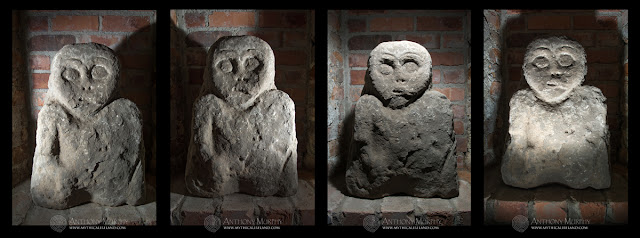 |
| An old photo showing the Sheela-na-gig in place in the wall of the mill. Photo courtesy Barbara Heise. |
About quarter of a century ago the ancient stone-carved figure was removed from its place in the wall of the mill for safekeeping. Before that, it had been whitewashed over so many times that it was becoming difficult to see its features.
The owners of the old mill, Georg and Barbara Heise, beautifully and lovingly converted the old structure into a modern habitable home. I was delighted to be given an opportunity by the Heise family to examine and indeed take photos of the Sheela-na-gig.
You might ask what a Sheela-na-gig is. They are "female exhibitionist carvings found on walls, abbeys, convents, churches, pillars and other structures in Ireland, England, Scotland and Wales, as well as in other parts of Europe. They come in many different shapes and sizes, but all share the same characteristic of a prominent and often enlarged genitals, often held open by the figure's hands. Most date from the middle ages."(1)
There are various theories as to what their intended meaning or purpose was, but we simply don't know for sure. Some suggest they were fertility figures, and that touching them was considered a blessing for assured pregnancy. Others say the fact they were often positioned on the walls of churches meant they served as a grotesque warning against the "sins of the flesh". Is the Sheela-na-gig supposed to represent a goddess? Or a crone/hag, like the cailleach?
Anyway, regardless of the theories, they are indeed fascinating. Here is a montage of photos I took of the Rosnaree Sheela. In order to capture as much of the detail as possible, I used a remote flash and illuminated the figure from left, right, above and below. Click the image to see a larger version.
 |
| Four views of the Sheela-na-gig, illuminated from the left, right, above and below. |
Here's a description from the Sites and Monuments Record (SMR) taken from the Archaeological Inventory of County Meath: "Sheela-na-gig now in private possession. Figure formerly built into wall beside door of mill that was not its original location. Removed from wall of mill and kept safe in store. Described by Freitag as a figure, ‘crudely carved on irregular stone slab; widest at bottom part which is cut straight, allowing figure to sit firmly on ground. Elongated, deeply hollowed out groove in crown of head (presumably for libations) further indication of figure originally free-standing. Left side defaced, and some damage also to chin, right forearm, right foot and lower part of leg. Large head, no ears, big owl-like eyes with eyebrows, clearly marked nostrils, jagged incision indicating mouth and possibly teeth. Four striations on right cheek running down to side of slab. No neck or breasts, but clearly marked navel. Right arm reaches under leg which is widely splayed, but no hands or fingers traceable. Genitals indicated by deep semi-circular depression’ (Freitag 2004, 140)."(2)
Recently, a link has been suggested between these grotesque Sheela-na-gig figures and the wife of Saint Patrick, who was called Sheela. The scholar who suggested that link, UCC folklorist Shane Lehane, says the following of the Sheela-na-gigs:
Sheela-na-Gig is a basic medieval carving of a woman exposing her genitalia. These images are often considered to be quite grotesque. They are quite shocking when you see them first. Now we look at them very much as examples of old women showing young women how to give birth. They are vernacular folk deities associated with pregnancy and birth.
I wish to express my thanks again to the Heise family for making me so welcome and for allowing me the opportunity to see this rare and fascinating relic of the past.
 |
| A photo of the old mill house at Rosnaree during winter floods a few years ago. |
References:
(1) Sheela-na-gig theories by Tara McLoughlin.
(2) http://webgis.archaeology.ie/historicenvironment/

Nice post and great photos.
ReplyDeleteThanks, Anthony. More food for thought....
ReplyDeleteThoroughly enjoying your articles of Slieve Gullion . I'm enthralled by all the connections with a lot of so many facets of our History.
ReplyDelete